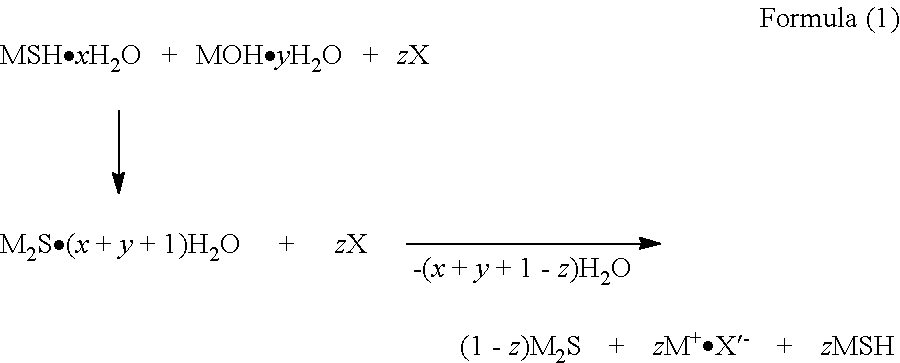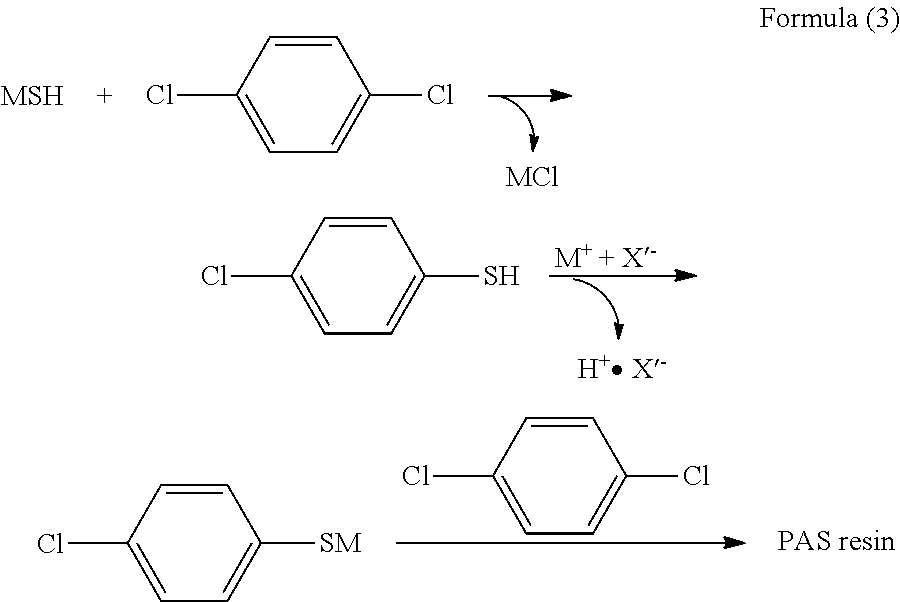Resin composition for hollow blow-molded article, hollow blow-molded article, and method of producing the hollow blow-molded article
- Summary
- Abstract
- Description
- Claims
- Application Information
AI Technical Summary
Benefits of technology
Problems solved by technology
Method used
Image
Examples
example 1
Step 1
[0110]Into a 150 liter autoclave equipped with a stirring blade and connected to a pressure gauge, a thermometer, a condenser, a decanter and a rectifying column, 33.222 kg (226 moles) of p-dichlorobenzene (hereinafter abbreviated as “p-DCB”), 4.560 kg (46 moles) of NMP, 27.300 kg (230 moles on a NaSH basis) of a 47.23% by mass aqueous NaSH solution, and 18.533 g (228 moles on a NaOH basis) of a 49.21% by mass aqueous NaOH solution were charged. The temperature of the resulting reaction mixture was increased to 173° C. over a period of five hours in a nitrogen atmosphere while stirring, 26.794 kg of water was distilled, and the autoclave was then sealed. The p-DCB distilled by azeotropy during dehydration was separated by the decanter, and returned into the autoclave as needed. A particulate anhydrous sodium sulfide composition was dispersed in p-DCB inside the autoclave after the completion of dehydration. The NMP content in this composition was 0.089 kg (0.9 moles). This res...
example 2
Step 1
[0113]Into a 150 liter autoclave equipped with a stirring blade and connected to a pressure gauge, a thermometer, a condenser, a decanter and a rectifying column, 33.222 kg (226 moles) of p-dichlorobenzene (hereinafter abbreviated as “p-DCB”), 3.420 kg (34.5 moles) of NMP, 27.300 kg (230 moles on a NaSH basis) of a 47.23% by mass aqueous NaSH solution, and 18.533 g (228 moles on a NaOH basis) of a 49.21% by mass aqueous NaOH solution were charged. The temperature of the resulting reaction mixture was increased to 173° C. over a period of five hours in a nitrogen atmosphere while stirring, 27.300 kg of water was distilled, and the autoclave was then sealed. The p-DCB distilled by azeotropy during dehydration was separated by the decanter, and returned into the autoclave as needed. A particulate anhydrous sodium sulfide composition was dispersed in p-DCB inside the autoclave after the completion of dehydration. The NMP content in this composition was 0.079 kg (0.8 moles). This r...
example 3
Step 1
[0116]Into a 150 liter autoclave equipped with a stirring blade and connected to a pressure gauge, a thermometer, a condenser, a decanter and a rectifying column, 33.222 kg (226 moles) of p-dichlorobenzene (hereinafter abbreviated as “p-DCB”), 2.280 kg (23 moles) of NMP, 27.300 kg (230 moles on a NaSH basis) of a 47.23% by mass aqueous NaSH solution, and 18.533 g (228 moles on a NaOH basis) of a 49.21% by mass aqueous NaOH solution were charged. The temperature of the resulting reaction mixture was increased to 173° C. over a period of five hours in a nitrogen atmosphere while stirring, 27.300 kg of water was distilled, and the autoclave was then sealed. The p-DCB distilled by azeotropy during dehydration was separated by the decanter, and returned into the autoclave as needed. A particulate anhydrous sodium sulfide composition was dispersed in p-DCB inside the autoclave after the completion of dehydration. The NMP content in this composition was 0.069 kg (0.7 moles). This r...
PUM
| Property | Measurement | Unit |
|---|---|---|
| Temperature | aaaaa | aaaaa |
| Fraction | aaaaa | aaaaa |
| Percent by mass | aaaaa | aaaaa |
Abstract
Description
Claims
Application Information
 Login to View More
Login to View More - R&D
- Intellectual Property
- Life Sciences
- Materials
- Tech Scout
- Unparalleled Data Quality
- Higher Quality Content
- 60% Fewer Hallucinations
Browse by: Latest US Patents, China's latest patents, Technical Efficacy Thesaurus, Application Domain, Technology Topic, Popular Technical Reports.
© 2025 PatSnap. All rights reserved.Legal|Privacy policy|Modern Slavery Act Transparency Statement|Sitemap|About US| Contact US: help@patsnap.com



